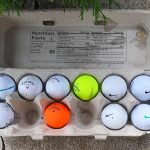The numbers on golf balls typically indicate the ball’s compression rating or serve as an identification marker. These numbers help golfers differentiate their balls during play.
Understanding the numbers on golf balls can enhance your game. Manufacturers print these numbers to provide key information. A single-digit number, usually between 1 and 4, helps identify a player’s ball on the course. Two-digit numbers often indicate the ball’s compression rating, which affects its feel and performance.
Higher compression numbers suit players with faster swing speeds, while lower numbers fit those with slower swings. Some balls feature three-digit numbers, denoting the dimple count. Recognizing these numbers ensures you choose the right ball for your game, improving your overall golfing experience.

Credit: www.youtube.com
Introduction To Golf Ball Numbers
Golf balls often have numbers printed on them. These numbers can be confusing for beginners. Understanding these numbers can help improve your game. In this section, we will explore what these numbers mean.
Purpose Of Numbers
The numbers on golf balls serve several purposes. Here are the most common ones:
- Identification: Numbers help identify your ball during play. Each player can use a different number.
- Compression Rating: Some numbers indicate the ball’s compression rating. This affects the ball’s performance.
- Model Number: Manufacturers use numbers to represent different models. This helps players choose the right ball for their game.
Common Misconceptions
There are many misconceptions about golf ball numbers. Let’s clear up some of them:
- All numbers are the same: Not true. Different numbers have different meanings.
- Higher numbers are better: Not always. It depends on what the number represents.
- Numbers affect distance: Only if they indicate compression. Otherwise, they don’t.
Understanding the purpose of these numbers can improve your game. Use this knowledge to choose the right ball for your needs.
Types Of Numbers On Golf Balls
Golf balls often have numbers printed on them. These numbers can be single-digit, two-digit, or three-digit. Understanding the meaning of these numbers can help improve your game. Let’s dive into the different types of numbers on golf balls.
Single-digit Numbers
Single-digit numbers range from 1 to 9. These numbers usually identify the ball for the player. For example, a player might use a ball marked with the number 3. This helps to avoid confusion during play.
Two-digit Numbers
Two-digit numbers typically range from 10 to 99. These numbers often indicate the compression rating of the ball. Compression rating measures how much the ball will compress when hit. A lower number usually means a softer ball, suitable for slower swing speeds. A higher number often means a harder ball, ideal for faster swing speeds.
| Compression Rating | Ideal For |
|---|---|
| 30-50 | Beginners, slow swing speeds |
| 60-80 | Intermediate players |
| 90-110 | Advanced players, fast swing speeds |
Three-digit Numbers
Three-digit numbers usually indicate the number of dimples on the ball. Dimples affect the ball’s flight and distance. More dimples can mean better aerodynamics. Numbers like 300, 400, or 500 are common. The number of dimples can influence how the ball flies through the air.
- 300-350: Standard dimple count
- 350-450: High dimple count for better control
- 450-500: Maximum dimple count for enhanced aerodynamics
Understanding these numbers can help you choose the right ball for your game. Use this information to improve your performance on the course.
Significance Of Single-digit Numbers
Golf balls come with various numbers on them. These numbers often hold significance for golfers. The most common are single-digit numbers. These numbers can range from 1 to 9. They serve specific purposes in the world of golf.
Player Identification
Single-digit numbers help golfers identify their balls. In a group game, this is crucial. Imagine you hit your ball next to another player’s ball. Identifying your ball becomes easy with a unique number.
Many golfers use balls with their favorite numbers. It adds a personal touch to their game. For example, a golfer might always use balls numbered 3. This number then becomes their identifier.
Custom Markings
Some golfers use single-digit numbers for custom markings. They might add initials or symbols next to the number. This further personalizes the ball.
Custom markings can include:
- Initials of the golfer
- Special symbols or logos
- Lucky numbers
These markings make the ball unique to the golfer. It reduces the chance of mix-ups during play. It also adds a bit of flair to the game.
Role Of Two-digit Numbers
Ever wondered what the two-digit numbers on golf balls mean? These numbers aren’t just random. They play a significant role in determining the performance and characteristics of the golf ball. Let’s dive into the specifics.
Compression Ratings
One type of two-digit number on golf balls is the compression rating. Compression ratings range from 30 to 120. This number indicates the ball’s softness or firmness. Lower numbers mean softer balls, which can travel farther for players with slower swings. Higher numbers represent firmer balls, offering more control for players with faster swings.
Here’s a quick guide:
| Compression Rating | Ball Type | Best For |
|---|---|---|
| 30-50 | Ultra Soft | Slow Swing Speeds |
| 50-70 | Soft | Moderate Swing Speeds |
| 70-90 | Medium | Average Swing Speeds |
| 90-120 | Firm | Fast Swing Speeds |
Manufacturer Codes
Another use for two-digit numbers is manufacturer codes. These numbers identify the ball’s make and model. Each manufacturer has its own coding system. Knowing these codes helps golfers choose the right ball for their game.
Some common manufacturer codes:
- Titleist Pro V1: Often marked with the number 1 or 2
- Callaway Chrome Soft: Frequently uses the number 3 or 4
- TaylorMade TP5: Typically marked with the number 5 or 6
Understanding these numbers can greatly impact your game. Choose the right ball based on these key identifiers.
Meaning Of Three-digit Numbers
Golf balls often have numbers printed on them, which can be confusing. These numbers serve different purposes. One specific type of number you might see is a three-digit number. Understanding these numbers can help you choose the right ball for your game.
Dimple Counts
Three-digit numbers on golf balls often refer to dimple counts. Dimples affect the ball’s flight and performance. More dimples usually mean a more stable flight. Most golf balls have between 300 and 500 dimples.
| Dimple Count | Flight Characteristics |
|---|---|
| 300-350 | Longer distance, less control |
| 350-450 | Balanced distance and control |
| 450-500 | More control, less distance |
Performance Indicators
Some three-digit numbers indicate the ball’s compression rating. Compression affects how the ball feels and performs. Lower numbers mean softer balls. Higher numbers mean harder balls.
- 70-80: Soft feel, suitable for slow swing speeds
- 80-90: Medium feel, suitable for moderate swing speeds
- 90-100: Firm feel, suitable for fast swing speeds
Choosing the right compression can improve your game. Match the ball to your swing speed. This ensures better control and distance.
Choosing The Right Number
Understanding the numbers on golf balls can enhance your game. Choosing the right number is essential. Golf balls have numbers for different reasons. They may indicate personal preference or performance needs. Let’s explore these factors further.
Personal Preference
Some golfers pick numbers based on personal meanings. They might choose their lucky number. Others may pick a number that holds sentimental value. For example, a golfer might select a number for a birthday. Some golfers even choose numbers for their superstition. While the number on the ball does not change its performance, it can boost confidence.
Performance Needs
Numbers on golf balls can also indicate performance characteristics. Some manufacturers use numbers to identify ball types. A table below illustrates common performance needs and corresponding numbers:
| Number | Performance Type |
|---|---|
| 1 | High spin for short game control |
| 2 | Low spin for long drives |
| 3 | Balanced spin for all-around performance |
| 4 | Extra distance and durability |
Choosing the right number based on performance needs can improve your game. A high spin ball helps with control around the greens. A low spin ball can add distance to your drives. Understanding these differences allows you to choose wisely.
Impact On Game Performance
The numbers on golf balls might seem trivial. They can significantly affect your game. Understanding these numbers can improve your performance on the green.
Distance And Control
Numbers on golf balls often indicate compression levels. Lower numbers mean softer balls, ideal for short distances. Higher numbers suggest harder balls, perfect for long-distance shots.
- Low Compression Balls: Best for slower swings. They provide excellent control.
- High Compression Balls: Suitable for faster swings. They offer more distance.
Choosing the right ball based on these numbers can impact your game. It helps in achieving the desired distance and control.
Player Confidence
Knowing what the numbers mean can boost your confidence. You can pick a ball that matches your play style.
- Identify your swing speed.
- Select a ball with the right compression number.
- Practice consistently with the same type of ball.
Confidence grows when you understand your equipment. A confident player performs better on the course.
Make sure to check the numbers on your golf balls. It can make a significant difference in your game.

Credit: www.golf-madness.com
Tips For Selecting Golf Balls
Choosing the right golf ball can improve your game. Each ball has unique characteristics. Understanding these can help you make better choices. Here are some tips to help you select the perfect golf ball.
Testing Different Balls
Test various golf balls to find the one that suits you. Different balls offer different levels of control and distance. Try a few and see which one works best for your swing.
Some golfers prefer balls with a soft feel. Others might like a firmer ball for more control. Testing will help you decide.
Consulting With Experts
Consulting with experts can provide valuable insights. Golf coaches or pro shop staff can recommend balls based on your skills and playing style.
Experts can analyze your swing and suggest suitable options. They might also provide samples for you to test.
| Characteristic | Soft Ball | Firm Ball |
|---|---|---|
| Feel | Soft | Firm |
| Control | Less | More |
| Distance | More | Less |
By testing different balls and consulting with experts, you can find the perfect golf ball for your game.

Credit: www.youtube.com
Frequently Asked Questions
What Do The Numbers 1, 2, 3, 4 Mean On Golf Balls?
The numbers 1, 2, 3, 4 on golf balls help players identify their ball during play. They don’t affect performance.
What Does The Number 1 Mean On A Golf Ball?
The number 1 on a golf ball typically serves as an identifier. It helps golfers distinguish their ball from others.
What Do The Different Colored Numbers On Golf Balls Mean?
Colored numbers on golf balls typically indicate compression ratings or are used for identification. Red often means low compression, black signifies high compression. Some brands use colors for personalization or aesthetic purposes.
What Does High Number Golf Ball Mean?
A high number on a golf ball usually indicates a player’s preference or identification. It doesn’t affect performance.
Conclusion
Understanding the numbers on golf balls can enhance your game. They indicate compression, identification, and performance characteristics. Choosing the right ball can improve accuracy and distance. Always consider these numbers for optimal play. Your game will benefit from the right choice.
Enjoy better performance on the course with this knowledge.





